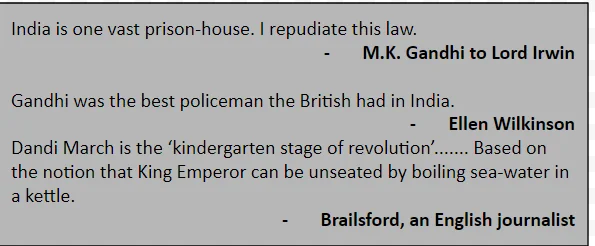Gandhi’s decision to suspend the civil disobedience movement, as agreed under the Gandhi-Irwin Pact, was not a retreat for several reasons Mass movements are inherently short-lived, and capacity of masses to make sacrifices, unlike that of the activists, is limited, Signs of exhaustion emerged after September 1930, particularly among shopkeepers and merchants who had participated enthusiastically. While some youth were disappointed, wanting a more dramatic conclusion, and peasants in Gujarat were upset about the delay in the restoration of their lands (which occurred only during the rule of the Congress ministry), many people were jubilant. They saw the government treating their movement as significant, engaging with their leader as an equal, and signing a pact with him. Upon their release from jail, political prisoners received a hero’s welcome.

Enroll now for UPSC Online Course
Constructive Programmes of Mahatma Gandhi during the Non-Cooperation Movement and Civil Disobedience MovementMahatma Gandhi, a central figure in India’s fight for independence, championed nonviolent resistance to challenge British rule. As a leader during the Non-Cooperation Movement (1920-1922) and the Civil Disobedience Movement (1930-1934), he revolutionized India’s freedom struggle by engaging the masses. Alongside these movements, Gandhi initiated various constructive programs aimed at social and economic improvement, self-sufficiency, and nation-building. Constructive Programme During Non-Cooperation Movement (1920-1922)
Constructive Programme During Civil Disobedience Movement (1930-1934)
Mahatma Gandhi’s constructive initiatives played a vital role in rallying the masses, promoting unity, and fostering social transformation. The impact of these initiatives showcased the effectiveness of Gandhi’s philosophy of nonviolent resistance and his vision for an independent India. |
Karachi Congress Session
In March 1931, a special session of the Congress convened in Karachi to endorse the Gandhi-Irwin Pact. Six days before the session, which took place on March 29, the execution of Bhagat Singh, Sukhdev, and Rajguru occurred. As Gandhi traveled to Karachi, he faced black flag demonstrations by the Punjab Naujawan Bharat Sabha, expressing their protest against his inability to secure the commutation of the death sentence for Bhagat and his comrades.
Congress Resolutions at Karachi
During the Congress session in Karachi, several resolutions were passed, marking a significant moment in its history.
- The Congress, while condemning political violence, expressed admiration for the bravery and sacrifice of the executed martyrs—Bhagat Singh, Sukhdev, and Rajguru.
- The endorsement of the Delhi Pact, also known as the Gandhi-Irwin Pact, was confirmed.
- The reaffirmation of the goal of complete independence, Purna Swaraj, was emphasized.
Two pivotal resolutions were adopted—one on Fundamental Rights and the other on the National Economic Programme.
The Fundamental Rights Resolution guaranteed various freedoms, including
- free speech,
- free press,
- right to form associations,
- Universal adult franchise,
- equal legal rights irrespective of caste, creed, and sex,
- neutrality of the state in religious matters,
- free and compulsory primary education, and
- protection to culture, language, and script of minorities and linguistic groups
The National Economic Programme Resolution focused on issues like
- the reduction of rent and revenue for landholders and peasants,
- relief from agricultural indebtedness,
- control of usury,
- improved working conditions,
- right to workers and peasants to form unions, and
- state ownership and control of key industries.
Enroll now for UPSC Online Course
This marked a historic moment as the Congress outlined what Swaraj meant for the masses, emphasizing the need for both political and economic freedom. The Karachi Resolution became the foundational political and economic program for the Congress in the years to come.
| Must Read | |
| Current Affairs | Editorial Analysis |
| Upsc Notes | Upsc Blogs |
| NCERT Notes | Free Main Answer Writing |
Conclusion
The first phase of the Civil Disobedience Movement, while temporarily suspended under the Gandhi-Irwin Pact, highlighted the dynamic interplay between mass enthusiasm and the limitations of sustained activism. Gandhi’s constructive programs and the Karachi Congress session further solidified the movement’s impact, underscoring his vision for a unified, self-reliant India. The resolutions passed at Karachi not only reaffirmed the goal of complete independence but also articulated a comprehensive framework for political and economic justice, marking a significant step in India’s struggle for freedom.
Sign up for the PWOnlyIAS Online Course by Physics Wallah and start your journey to IAS success today!
| Related Articles | |
| Civil Disobedience Movement | Lahore Session 1929 |
| Mahatma Gandhi | Gandhi Irwin Pact |

 GS Foundation
GS Foundation Optional Course
Optional Course Combo Courses
Combo Courses Degree Program
Degree Program











